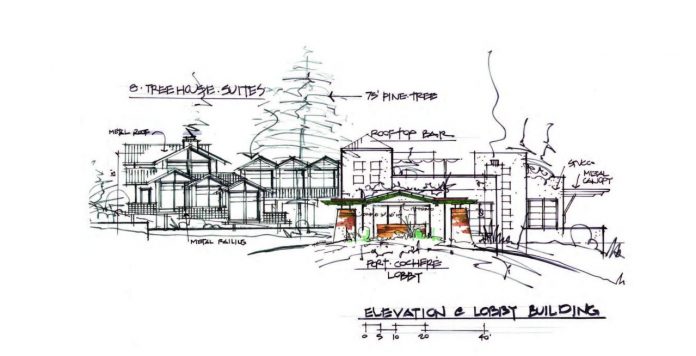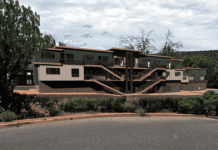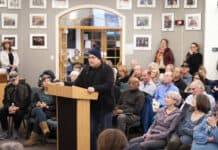
Curt and Robin Baney purchased land in West Sedona 14 years ago with the hope of someday building a hotel, adding to the list of ones they already have.
Over the years they have come before the city with a variety of plans for the land but nothing came to fruition. Now, they’re looking to change that.
A revised conceptual review of zone change and development review application was discussed for nearly two-and-a-half hours during the Tuesday, Oct. 6, Sedona Planning and Zoning Commission meeting for a development that’s being called Village at Saddlerock.
The item was for discussion and direction only, so no action was taken.
A city report states the Baneys are seeking review of a Conceptual Zone Change and Conceptual Development Review with the intent of developing a proposed mixed-use project with 128 lodging units, a restaurant, meeting space, 44 multifamily housing units and a new connection from Saddlerock Circle to the traffic signal at State Route 89A and Soldier Pass Road. The plan also calls for surface parking lots and an underground parking structure.
“This has been not only a project that is near and dear to their hearts but also because they have roots in Northern Arizona,” said Jason Morris, speaking on behalf of the Baneys. “This is part of their family-owned business — Oxford Suites — that consists of 17 properties in four different states.
“With each of their properties, they are involved within those communities and that is the hope with this project. This is something they have long pursued and their goal in having this property is to turn it into one of their premier sites.”
In all, 11 parcels totaling 6.36 acres were purchased for this development, the largest being owned by the Biddles family. It was also the former homestead for the Cooks family, one of the early settlers in the Sedona area.
The original plan called for building a 100-room hotel along with 8,000 square feet of retail space, a restaurant and bar, and 16 multi-family housing units that may be sold or rented.
“Apart from this project, the city is experiencing significant housing challenges and is continuously exploring opportunities to increase the amount of housing available within the city,” the report states. “While brainstorming ideas for housing, staff saw an opportunity with this project site.
Therefore, staff contacted the applicant and requested that they consider abandoning the retail component and instead focus on maximizing the residential component. Staff believed that, based on current conditions, increasing the amount of housing by eliminating the retail component could have significant long-term benefits.”
As the proposal currently stands, of the 44 units, 32 would be studio apartments with the remaining 12 being one- and two-bedroom apartments. Sixteen of those studio units would be dedicated to workforce housing. It’s not known at this time if the workforce housing would be available to just Oxford employees or the general public.
Project spokesman Ben Tate said the idea to eliminate the retail aspect of the project and expand the housing component came as a result of a meeting with the city in February. He said the conceptual design allows for flexibility when determining how many studio apartments they offer compared to one- and two-bedroom units.
“One of the things we’re seeking from the commission is a little bit of direction as far as what the desire is and where the value is placed upon,” he said. “Is it simply having as many units as possible to add to the inventory, or is there a desire to see a greater mix?”
Several of the commissioners pointed out aspects of the project that they like and many praised the owners for putting an emphasis on housing. But they also expressed concerns such as traffic and questioning the need for another hotel. There were mixed feelings in terms of the split between the number of studio apartments and ones that would cater more toward families.
To those concerns, Tate said that the property will be built upon whether it’s a hotel or what it’s currently zoned for, which is commercial and multi-family residences. Either way, it will generate more traffic.
“I can assure you, the average number of daily trips you’re going to generate from a commercial use versus a lodging and residential use, the commercial use will almost assuredly be higher,” he said. “It will not only be different in the number of trips but different during the peak hours.”
As for the additional hotel rooms, Tate added, “Lodging is going to be built whether it’s in the city of Sedona proper, the Village of Oak Creek or Cottonwood, and those people are still going to come to Sedona.
“So the question is, does the city of Sedona want to benefit from it or do they want other cities to obtain those benefits? We think we’re providing something that allows the city to take advantage of the [financial] benefits that come with it rather than getting the traffic.”





















